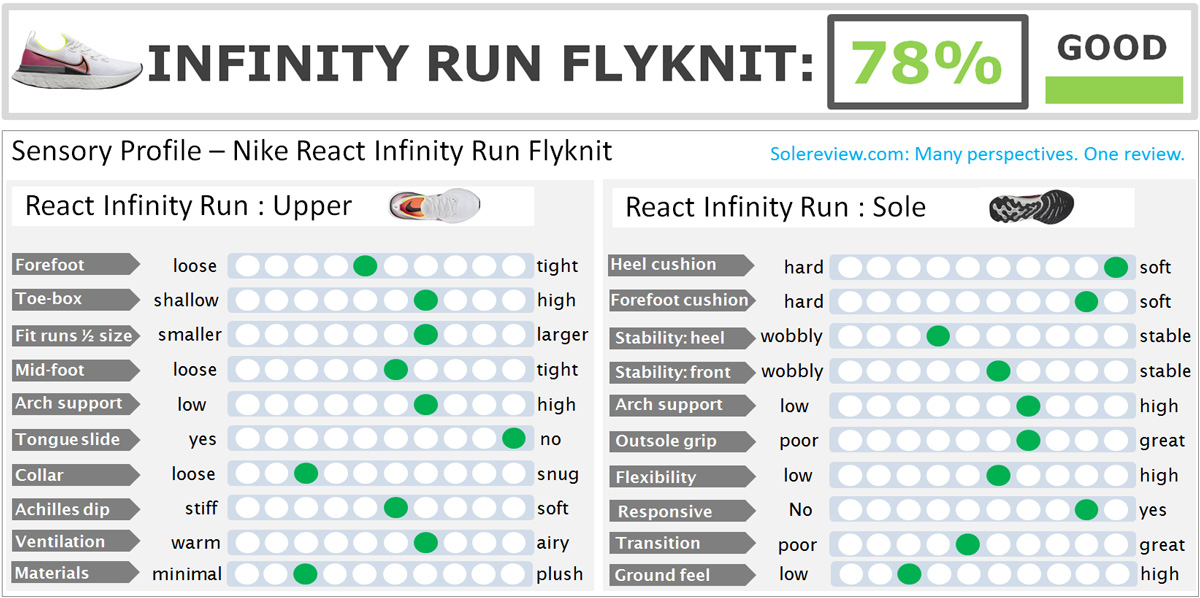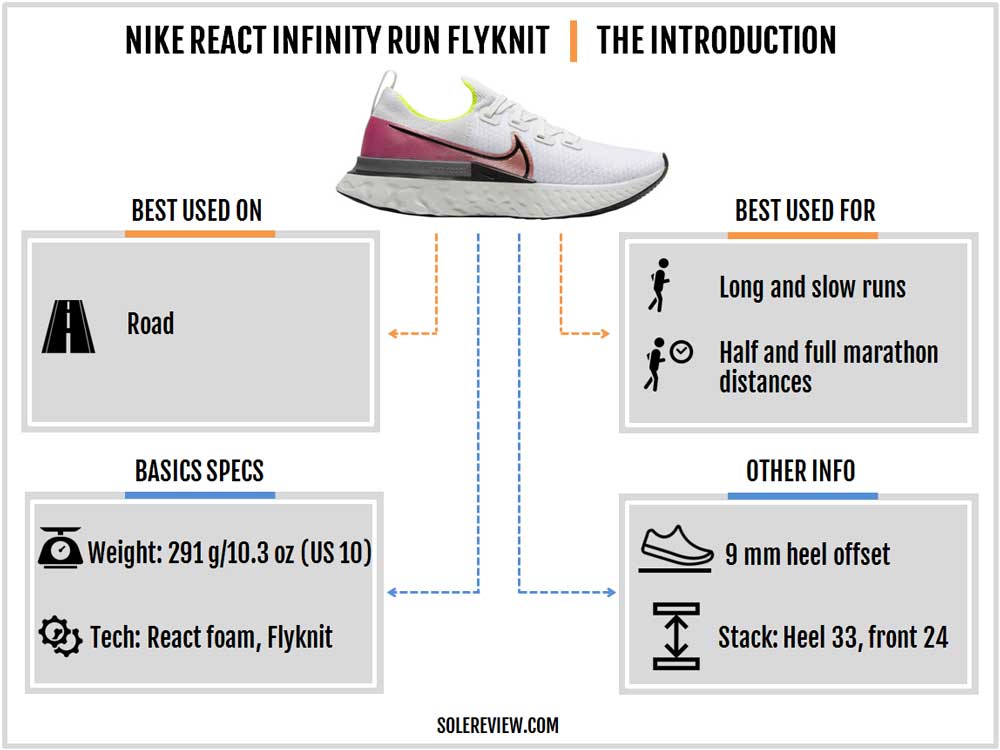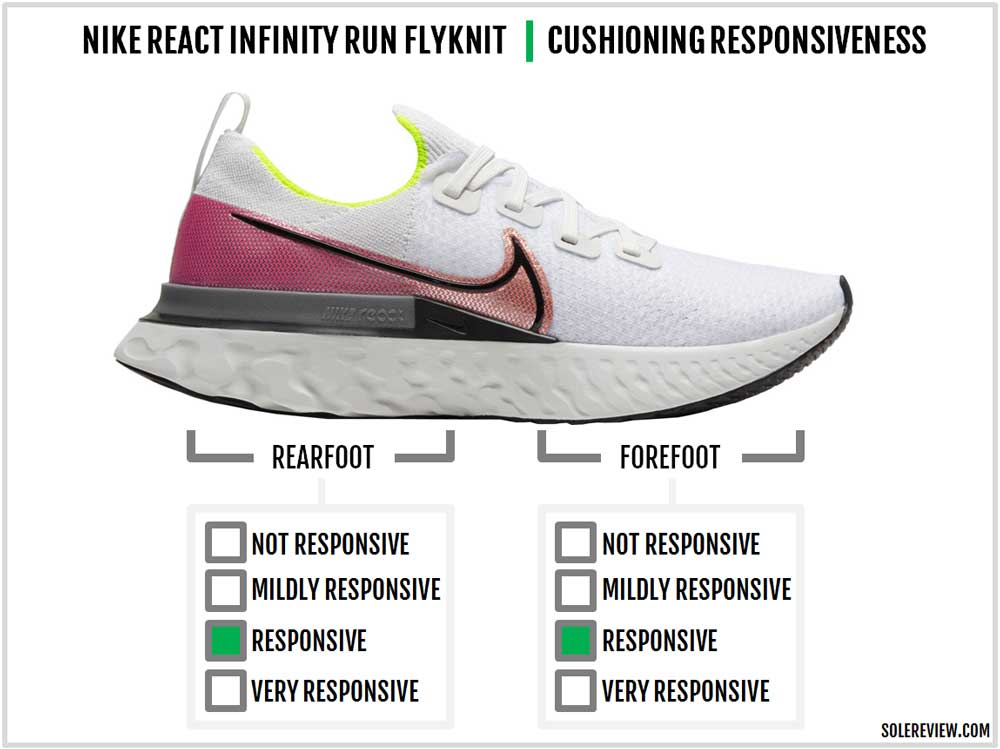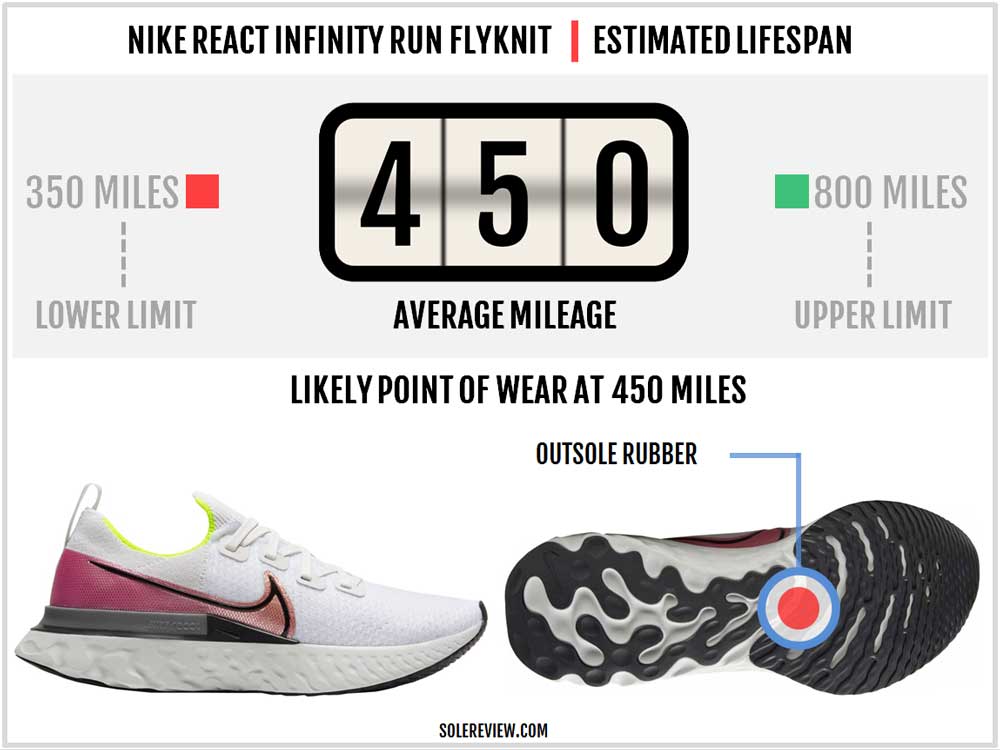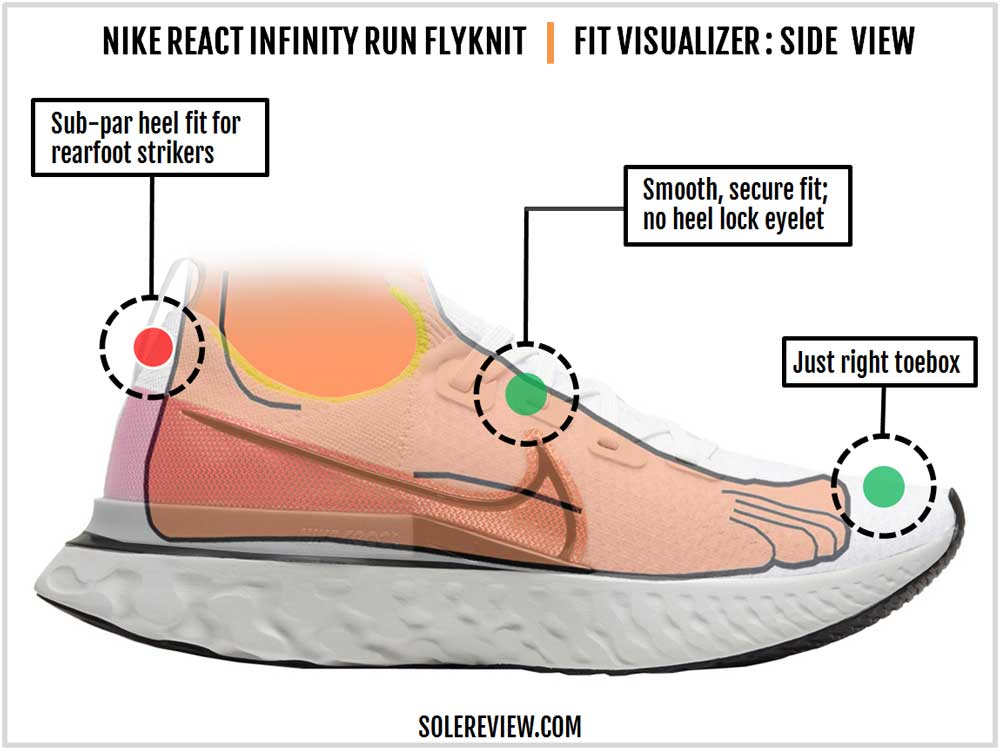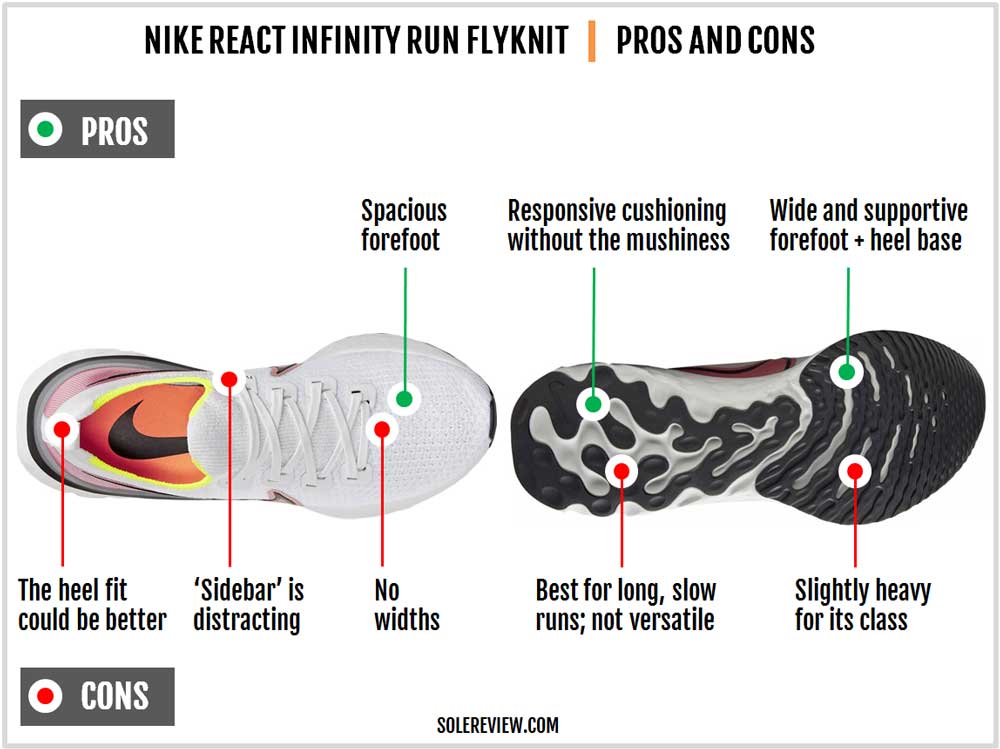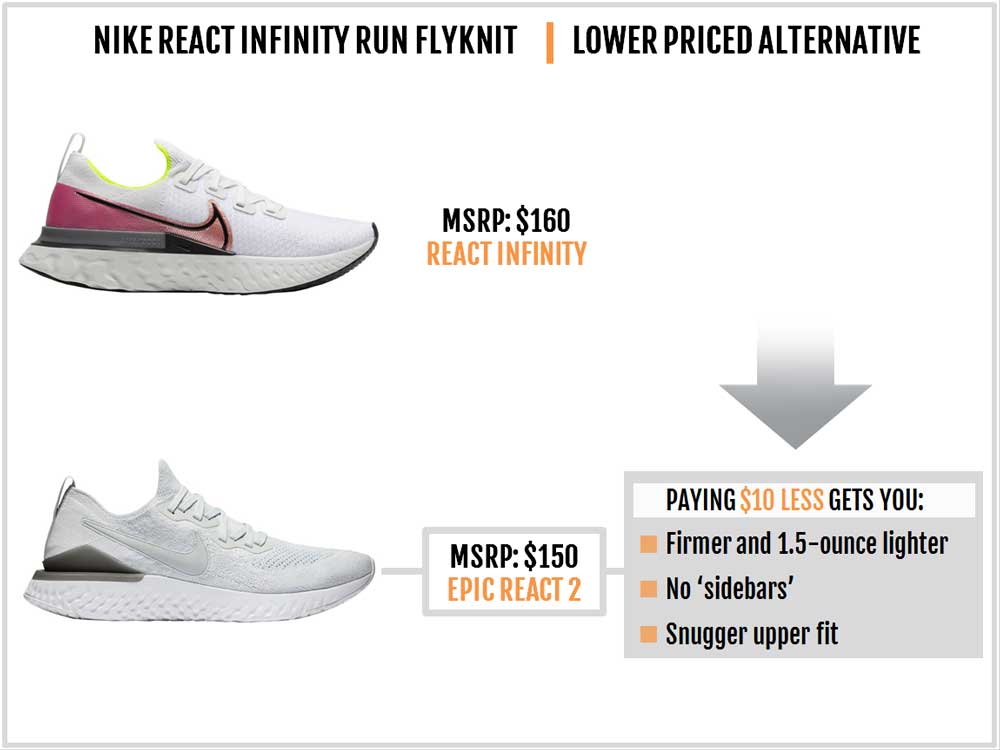INTRODUCTION
No, the Nike React Infinity Run is not a replacement for the Nike Structure 22.
And who even suggested that? Nike did – sort of.
Nike advertises the Infinity Run as a running shoe that reduced injuries by 52% compared to the Nike Structure 22.
For those who are unfamiliar with the Zoom Structure, know that it has long been the cornerstone of Nike’s stability shoe category. As far as Nike running shoes with a firmer medial post go, the Structure 22 is the last of its tribe.
And now suddenly the Structure 22 is the bad guy that injures 30% of runners? Wow.
As with all marketing claims like ‘60% more responsive’ or ‘42.99% increased comfort’, swallow the React Infinity versus Structure comparison with a large grain of salt.
These statements sound so absurd, it is almost comical. It’s like Nike saying, “ You have the previous year’s model? Very bad. Bad running shoe. Throw it away. Bad. Ha, ha, loser. Now try this new running shoe with the XYZ tech; it will change your life.”
The meaningless comparison between the Structure and Infinity Run seems forced – as if Nike had run out of things to say. Also, the two shoes couldn’t be more different.
The Structure 22 is a very firm running shoe with a medial post. On the other hand, the React Infinity Run is a soft, highly-cushioned shoe with a neutral ride.
There is nothing that ties them together – except for the notion of a ‘supportive neutral’ concept. The way we see it, this will likely be Nike’s new stability shoe standard going forward.
Nearly five years ago, we questioned the need for a medial post in this article. We argued that modern materials and construction techniques made some neutral running shoes supportive enough, so firmer wedges were, for the most part, redundant.
Some of that thinking was inspired by the Brooks Transcend. In 2014, it was the first stability shoe to abandon the medial post and adopt ‘Guiderails’ on top of the midsole. Today, most of Brooks’s stability line-up – including the Beast 20 – have adopted the raised sidewall design. adidas and Saucony have jumped on that too.
Nike has been uncharacteristically late for this event. But here we are with the React Infinity Run.
However, the Infinity Run isn’t the supportive neutral Solereview had in mind. Though this shoe features Nike’s version of midsole Guiderails ( we’ll name it the ‘sidebar’), the deeply-cushioned midsole is a very soft kind.
A very soft midsole is useful for long-distance cruising at relaxed speeds. That the React Infinity does very well; there’s plenty of underfoot comfort without the mushiness of traditional EVA foams.
At the same time, the Infinity Run isn’t the epitome of stability. And that’s not just because of the high-volume midsole; the upper lacks the desired level of rearfoot lock-down for anything other than straight-line running.
So while this is a trainer with a very comfortable ride, it’s just not very versatile.
THE RIDE EXPERIENCE
The visual and material aspects of the Infinity bears resemblance to the Epic React, so one might expect a shared ride quality. But that isn’t the case. Though the Infinity Run has a React midsole, it’s not the same React foam as the Epic or what the Turbo uses for its lower midsole.
The Infinity Run’s midsole uses a low-density React foam with plenty of softness. Not only is the ride soft, but it is also deeply cushioned. Loading your weight on the midsole results in a noticeable squish; making that happen is a couple of factors.
There’s a wide midsole flare under the heel and forefoot. This adds a lot of volume compared to normal-sized midsoles, and with that comes greater cushioning depth.
As they say, hindsight is 20:20. With a soft ride quality, the React Infinity Run fills a gap in Nike’s line that we didn’t realize existed. After the Vomero turned into whatever it has now, there wasn’t a true max-cushion running shoe in Nike’s assortment.
What of the Vaporfly and Next%? Those are ‘conditional’ max cushion shoes, and besides, they cost too much. The Pegasus Turbo 2 has a nice bounce, but it’s more of ‘fast’ cushioned shoe.
So if you wanted a cushioned Nike running shoe for leisurely runs, there was no place to go. The Epic React 2 fulfilled that need to a certain extent, but it lacks a soft ride. In the past, there were shoes like the LunarEpic, but those are now historical footnotes in Nike’s catalog.
So – the React Infinity Run is that shoe; the kind that powers through high-mileage runs in cushioned comfort. It’s best for unhurried runs on easy days – or to use a well-worn cliche – ‘recovery runs’.
This should be the shoe in your rotation when you plan to run at paces 6 min/km and slower. The distance is immaterial; whether you’re taking the React Infinity out for a daily 5k run or a 20k cruise, there’s plenty of un-rushed comfort protecting your foot.
It’s worth underscoring that the cushioning isn’t served with mushiness. Nike’s React foam is synthetic rubber-based that doesn’t bottom out as EVA foams or even the way Lunarlon did.
Though the rocker-shaped midsole and low forefoot flexibility help the foot transition through the gait cycle, a firmer lasting would have made it easier.
A part of the reformulated React midsole’s appeal is its inherent responsiveness or springiness. If you have experience with both ZoomX foam and Epic React, then we’d plot the Infinity’s responsiveness as somewhere in between.
And like any other shoe, the responsiveness would have improved with a thicker insole and lasting – something that the React Infinity lacks.
Stability is ok here, because much of it is situational. If all you’re doing is forefoot-striking on straight roads, then the Infinity fares pretty well. The Urethane ‘sidebars’ on the midsole aren’t mere decorations; they add functional support.
The trouble begins when the React Infinity is deployed on unpaved surfaces or routes that involves pushing hard into corners. Examples of this would be mild trails that are slightly uneven. Or for that matter, speedy interval training on synthetic tracks. Investing conscious effort into going fast only yields cushioned frustration.
There’s too much shoe in the soft, full-bodied midsole to do anything other than straight-line running on paved surfaces. If you do decide to go off-road or speed up into corners, the foot tires fairly quickly as it overcompensates for the lack of stability. Elsewhere, we said the same thing of the Nike Vaporfly.
Apart from the midsole softness, the upper fit is also a factor here. The character of the upper mirrors the relaxed midsole – the fit is spacious and easygoing. The relaxed hold makes long runs comfortable but doesn’t pin the foot down during faster workouts.
This is why the ‘reduced injury’ claim should be taken as nothing more than marketing talk. What if someone decides to take the React Infinity Run off-road? In such cases, a diminished level of proprioception can potentially result in increased stress or mild injuries.
When it comes to outsoles, there’s nothing like good ol’ rubber.
The Infinity’s outsole overs a large area while leaving a lot of foam exposed between the grooves. This geometry is superior to the larger slabs layout used on the Epic React; this way, you get better traction as well as the ability to work/flex together with the midsole.
There are two more things worth noting. Though on the paper the midsole (24 mm front, 33 mm rear) has a 9 mm drop, the actual offset will differ due to the softness.
When compressed, the travel will cause the drop to go lower than the published specs. The ‘Achilles travel’ may also cause initial Achilles/calf soreness – especially for runners who haven’t run in lower offset (6 mm and under) shoe recently.
This isn’t a deal-breaker, but just know that temporary discomfort may occur. The said midsole behavior also affects the heel fit – something that’s covered in the upper fit breakout.
The gist is – think of the React Infinity Run as a motorcycle with a low RPM engine for freeway cruising. If corner-carving is what one has in mind, then one needs to hop on a different product.
As long as you temper your expectations around the Infinity Run’s lack of versatility, you’ll end up with a trouble-free experience. The feet feel less tired after spending long hours on the soft midsole. Outside of the Vaporfly (including the Next %) club, this is the most comfortable Nike running shoe you can buy.
Within a hypothetical three-shoe rotation, the Infinity Run fulfills the need for easy long-distance runs.
Since the Zoom Elite or the Rival Fly no longer exist, the Pegasus 36 fills the role of a versatile trainer. The firmer ride allows you to go faster without worrying about the upper lockdown or the soft midsole. The Pegasus 37 is due for release, so you might also want to wait.
For some runners, the Pegasus feels like too much of a shoe. If that’s you, getting a lightweight and firm trainer like the New Balance 890V7 or the adidas SL20 are pace-friendly options. For a softer ride, there are options like the New Balance Tempo and the adidas Boston. Our pick will be the Reebok Run Fast. It’s got a supportive rim on top of Reebok’s lightweight and cushioned Floatride midsole.
Use the Zoom Streak 7 or the LT 4 for speed runs and interval training. Our favorite is the Reebok Run Fast Pro though. Its featherweight build and extra-grippy outsole make it a pleasure to do speed runs in.
Among the less expensive options are road-racers like the Asics Tartheredge, the New Balance 1400, and the Saucony Type A9.
IS THE NIKE REACT INFINITY RUN DURABLE?
The overall build quality and outsole design suggest that the Infinity should last more than 400 miles. Past React-based models have demonstrated satisfactory cushioning longevity, and that should be the case for the Infinity as well.
When compared to larger slabs/lugs, an articulated outsole – like the one on the Infinity – does a better job at resisting wear and tear.
The grooves make it easier for the outsole to telescope into the soft midsole. This behavior helps spread the transition stress over a larger area.
It’s business as usual with the thick Flyknit upper; we do not foresee any material failures.
THE UPPER DESIGN AND FIT
Yes, we know what you’re here for. You want to know what Solereview thinks of the Infinity’s heel fit. We’ll cover that soonly.
From the outside, the upper appears fairly straightforward. It’s a regular Flyknit design that is now commonplace on most Nike models .
However, there are a couple of things you need to know about the Infinity Run’s seemingly innocuous upper. The fit also depends on who’s wearing the shoe, so these observations will not apply to everyone.
The heel fit behavior is a symptom and not the cause. It’s a symptom – mostly – of a soft midsole that lacks a supportive base under the heel. Unlike Nike shoes with Zoom Air bags and a cellulose under-board, the Infinity has a very thin insole (think Free 3.0 Flyknit) and lasting.
When you add a very squishy midsole to this set-up, and the foot travels a few millimeters during the loading process. And that’s where most of the slipping sensation comes from.
This is not a new occurrence; even our Vaporfly 4% review called out the same thing. In both cases, the feeling of a loose heel is worse than the slippage itself – it’s not like your heel pops out of the shoe.
Under the circumstances, even a full-sized internal heel counter wouldn’t have made a huge difference.
We also believe that the wide midsole also plays a part in the heel fit. Our theory is that a wider base also translates into a somewhat wider fit inside the heel
The lack of heel-lock lacing wouldn’t have been much of a concern if it weren’t for the soft midsole. But here, the sixth row would have helped.
The heel fit is going to be less of an issue for forefoot strikers than runners who land heel first. Thus, how far the foot ride along the Achilles depends on personal biomechanics; heel and forefoot strikers will perceive the heel fit differently.
In the rear, the heel loop is soft-seamed inside the Achilles, and that gets in the way of an otherwise seamless interior. Though the loop design is an improvement over the Epic React V1, the Infinity should be paired with running socks.
The urethane ‘sidebar’ over the midsole extends to the under-arch area. Runners who have a broad midfoot or tend to load the arch area may experience a dull pressing sensation from the raised section.
It doesn’t help that the sidebar tapers at an acute angle instead of gently cupping the arch. This peculiar design isn’t a source of discomfort but the sense of having something under your arch is a distraction.
The rest of the upper is ok. The forefoot is wide and spacious – which is the result of a wide midsole base. There’s plenty of room inside for the foot to splay. Though the upper fits slightly larger, we recommend going true to size.
There’s a bit of a stretch, but a far cry from the early versions of super-tight and super-stretchy Nike Flyknit upper. Although, when compared to traditional running shoe uppers with a separate tongue, stepping inside the Infinity takes a little more effort.
The upper isn’t overly elastic, so you have to be careful while lacing the first two rows. The materials may gather/bunch if the laces are pulled tightly.
Regardless of the spacious toe-box, buying true to size should do it. Like most Nike running shoes, there are no optional widths for the Infinity.
PROS AND CONS
Of many things that the Infinity Run does very well, its deeply cushioned ride stands apart. The soft midsole goes easy on your feet when the mileage creeps into double digits.
The cushioning is a non-mushy kind so one doesn’t have to labor through the softness. The wide midsole flare creates a wide, supportive foundation that also contributes to the overall cushioning volume.
The Infinity React’s forefoot is nothing like some of the overly-narrow Flyknit designs. Here, there’s plenty of toe-box room without the vice-like tightness.
Depending on the person, the heel fit can be a miss. The soft midsole causes a certain amount of ‘Achilles travel’, and there’s no heel lock lacing to save the day.
The under-arch bump resulting from the midsole sidebar is a distraction. Other smaller areas for improvement are the lack of widths and reflectivity. The 10-ounce+ weight is also a departure from past React-based models.
One could also view the lack of versatility as a shortcoming, but that’s debatable. The soft ride and the less-than-ideal levels of upper lock-down mean that the React Infinity Run is only good for straight-line running on paved surfaces. This isn’t a shoe for faster paces either.
The React foam will stiffen in extreme cold, but not to the extent as the Epic React does – thanks to the added softness.
SHOES SIMILAR TO THE REACT INFINITY RUN
We cover the Epic React 2 in a separate section, so we’ll bring up the Nike Pegasus Turbo 2 for discussion. If you’re searching for a Nike shoe that melds a soft and responsive ride along with fast-run capabilities, then the Turbo 2 could very well be it.
This list features other familiar names from the max-cushion world. The Hoka Clifton is in its sixth year running; the New Balance 1080V10 is in the best shape of its life.
Asics has recently upped the stakes. First came the GlideRide and its derivatives. The Novablast is another winner from the Japanese brand – this is a cushioned shoe that also feels lively.
Skechers’ lightweight Hyberburst foam is great for longer distances, but the upper on the MaxRoad 4 Hyper could do with several fit improvements.
The Saucony Triumph 17 barely manages to squeeze into this list. Unlike other models that have a relatively minimal design, the Triumph happens to be a full-bodied distance trainer. The Pwrrun+ foam is excellent for high-mileage comfort – and a vast improvement over the Everun.
THE NIKE REACT INFINITY RUN vs. EPIC REACT 2
Though both the Infinity and Epic share the same midsole compound and a published heel drop of 9 mm, they are two very different shoes.
The Epic React 2 has a firmer ride within a much lighter build. It under-weighs the Infinity by over an ounce and half – that’s a huge gap.
The firmer ride also helps the heel grip better. With a firmer base, the foot doesn’t travel into the midsole and cause the sensation of slippage.
The Epic React is more versatile of the two. The firm and lightweight midsole works together with the superior upper lock-down to produce a ride character that is capable of quicker runs as well as long-distance cruising.
Retail price-wise, not much separates the two – just $10.

